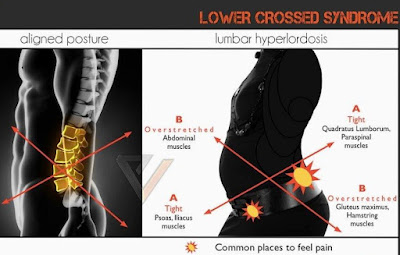Lower-Crossed Syndrome (#LCS ) is also referred to as distal or pelvic crossed syndrome.
This syndrome can be found in individuals who sit for prolonged periods, continuously perform tasks for extending periods of time utilizing poor posture, or have been immobilized. It can also be found in individuals who perform repetitive actions such as running or jumping.
Muscle Imbalance
The muscle imbalance pattern will affects the lower back, lower kinetic chain which includes the lumbopelvic hip complex, knee, and ankle and causes severe low back pain.
Lower back and hip pain:
To fully comprehend the reason of Severe Back pain as to why there is a muscle imbalance, we need to understand the concept that when a muscle is in a shortened or tightened state (ie. such as in Prolonged sitting and poor postures) for long periods of time, it causes the weakening of muscles on the opposite side of the body. This is referred as the “automatic reflex inhibition” by the brain.
In LCS, tightness of the thoracolumbar extensors on the dorsal side crosses with tightness of the iliopsoas and rectus femoris. Weakness of the deep abdominal muscles ventrally crosses with weakness of the gluteus maximus and medius.
If these muscle differences are left untreated, the joints and muscles around may undergo changes progressively. Strength, flexibility and range subsequently decrease, which contributes to degenerative changes and pain in the lower back
This pattern of imbalance creates joint dysfunction, particularly at the L4-L5 and L5-S1 segments, SI joint, and hip joint. Specific postural changes seen in LCS include anterior pelvic tilt, increased lumbar lordosis, lateral lumbar shift, lateral leg rotation, and knee hyperextension. If the lordosis is deep and short, then imbalance is predominantly in the pelvic muscles; if the lordosis is shallow and extends into the thoracic area, then imbalance predominates in the trunk muscles.
When treating patients with LCS the shortened muscles must be restored before embarking on training of the weakened muscles. This is based on Sherrington's Law of reciprocal inhibition which states that when one muscle is shortened or tightened its opposite muscle relaxes.
However, physiotherapy can help to prevent these secondary degenerative changes and treatment techniques are largely aimed to stretch the tight muscles and to strengthen those that have been weakened so as to enhance optimal muscle function and to improve postural alignment of the lower back.
Lower Crossed Syndrome Treatment Options for a PT Lower Back Pain Treatment at home/ Physiotherapy for low back pain
• Postural Training / Functional Training
• Sensorimotor training
• ROM exercises. Stretching for lower back pain / lumbar spine/back and hip/groin/knee
• Strengthening/Stabilization for lumbar spine/back
• Manual Therapy / Joint Mobilization / STM / Myofascial Release
• Strengthening/Stabilization for hip/groin/knee)
• Modalities etcWhat’s the difference?
The two types are similar and display the same main muscle imbalance characteristics. However, Type B is due to primarily weakness and length of the abdominal wall giving a shallower, longer lordosis (when compared to Type A) which extends into the thoracolumbar area, with a more cranial shift of the kyphosis, anterior pelvic tilt, and genu recurvatum. While Type A is chiefly due to the shortness of the hip flexors leading to a deeper, shorter lordosis (when compared to Type B), it does not extend into the thoracolumbar region and is confined to the lumbar spine with chronic shortening of the hip flexors leading to knee flexion.




.jpeg)










.jpg)


.jpeg)